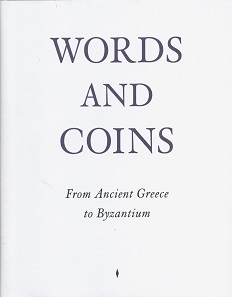by Ursula Kampmann
translated by Annika Backe
July 20, 2017 – In 2012/2013 an exhibition was presented in Cologny, a suburb of Geneva, which bore the enigmatic title ‘Words & Coins – From Ancient Greece to Byzantium’. This joint project involved the Fondation Martin Bodmer, the Greek KIKPE Foundation and the Benaki Museum. The subject of the exhibition was ambitious, intellectual and unusual: To what extent are coin imagery and words linked? How do they influence each other and how do they interact?
Vassiliki Penna (ed.), Words and Coins. From Ancient Greece to Byzantium. MER. Paper Kunsthalle, Ghent, 2nd edition 2014. 188 pages with b/w illustrations and 170 color plates, 27.7 x 22.2 cm, Hardcover. ISBN: 978-94-9177-550-5. 56.13 euros plus postage.
The catalog has a bibliophile appearance: precious paper, artistic photos against a black background, and an impressive team of international writers who have authored the essays. Constituting nearly one third of the book, these essays deal with topics such as coinage and writing in the history of ancient Greece, the relationship between the myths as handed down or depicted on coins, or the representation of the saint in the Byzantine culture, to name but a few of the 10 subject-matters.
The catalog proper is divided into 15 short sections, each giving the numismatic sources opposite the written ones. The beginnings of Greek coinage – which makes the first stop of the exhibition and is highlighted as a typical example here – are accompanied by precious Renaissance cradle books devoted to works written by ancient authors including Homer, Aristotle, or Plato, who address monetary or economic issues.
Coins and the books related to them – this consistently, this is an absolute novel approach for an exhibition, as far as I know. It’s important to repeat, tough, that these books are not numismatic works but prints by ancient authors who are dealing with topics as they are also featured on coins.
In order to appreciate the objects’ beauty, the two parts of the text are preceded by a plate section, which constitutes about another third of the book. It doesn’t address the mind but the eye. There is no explanation whatsoever as to what is actually shown. A concept not everybody might appreciate. Or, to quote a well-known Swiss museum director: “Never leave your visitor in the dark. That’s what the boards do, albeit it’s a very beautiful darkness.”
‘Words and Coins’ is an inspiring book that highlights an entirely different aspect of ancient numismatics. It targets a very well-informed audience that is intellectually able to appreciate the indicated cross-connections between books and images. Those who are familiar with both the ancient literature and numismatics will appreciate the stimuli this exhibition catalog provides.
You can order the book for €56.13, plus postage, in the English or the French edition.





